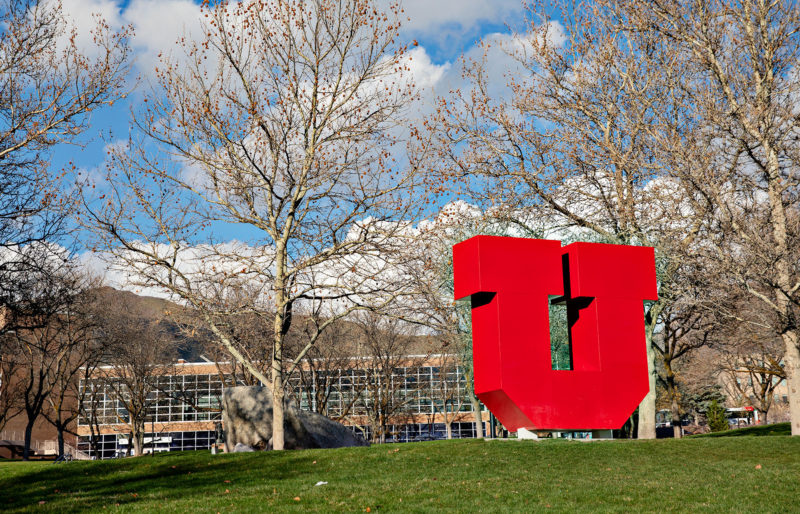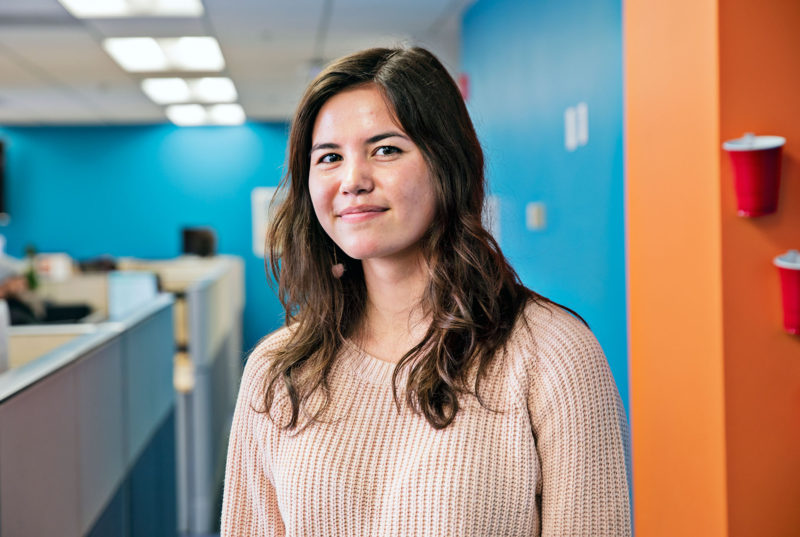A new way of helping students pay for college: Give them corporate jobs

A call center near the University of Utah where students can make money and get help with their tuition by working for Microsoft and Discover. The companies get reliable employees and prospective hires while universities can promise students help with keeping their loan debt low.
SALT LAKE CITY — On the third floor of a downtown office building, Solomon Kalapala was chatting with a Microsoft customer on one computer screen while troubleshooting the customer’s misbehaving software on another.
“I’m basically running a repair,” said Kalapala. If the online fix didn’t work, he explained, “I’ll do an uninstall and reinstall.”
Pink Floyd blared in the background as Kalapala went about his work. His colleagues filled cubicles that stretched the length of the building, their work spaces adorned with the trumpery of office life — a mini basketball hoop, a life-sized cutout of the Big Lebowski. Next door was a break area with big-screen TVs, an Xbox console and a ping-pong table.
These aren’t typical call center employees, however. They’re among about 300 University of Utah students who have side jobs here arranged by a nonprofit called Education at Work.
Founded by a call center executive, EAW sets up partnerships between universities and large employers to provide jobs like Kalapala’s. The employers get reliable employees and prospective hires while the universities can offer students a novel way to work for tuition and keep their loan debt low.
The students also get work experience, said Taylor Randall, dean of the University of Utah’s David Eccles School of Business.
If we’re trying to get people ready for jobs, the more we can make school look and feel like the real world, at some point, the better off it is.
Taylor Randall, dean of the University of Utah’s David Eccles School of Business on the Education at Work program
“They learn a set of remarkable customer service skills,” said Randall. “In my mind, they learn it better here than they would just listening to it in the classroom.”
As students struggle with college costs and the strain of balancing work and school, Education at Work provides a little-noticed new way of leveraging corporate America’s thirst for skilled talent and colleges’ desire to tout how well they prepare young people for careers. The nonprofit employed 488 students on four campuses last year and has plans to expand to 1,521 by 2021.
Offering part-time corporate work can allow the school to say, “Yeah we’ve raised tuition, but guess what, we’ve got this program, you can pay for over half your education, in the University of Utah’s case,” said Randall. EAW’s University of Utah graduates end up with half the student loan debt of their peers, the organization reports.
Kalapala spends about 25 hours a week at his Microsoft customer support gig, a quick downhill trek from the university campus in the nearby foothills. It beats his previous job — a summer of cold-calling alumni for donations — which he said he hated.
He makes $9.75 an hour, which is higher than the state’s minimum wage. Other students here work for Discover Financial Services, where the pay starts at $10 an hour. All EAW student workers also get up to $5,250 a year toward their tuition, depending on their grades and work attendance. Since EAW began operations in Utah in 2017, about 325 students have received $700,000 in tuition assistance, the organization said; Kalapara said he’s so far netted $2,200 toward his tuition.
Education at Work has similar arrangements with Arizona State University, Northern Kentucky University and Ohio’s Mount St. Joseph University. The companies pay EAW, which then pays the student workers, while the universities provide the office space. The University of Utah spends about $600,000 a year for the lease, utilities and janitorial services for the three floors Education at Work occupies in the downtown Salt Lake City building.

The University of Utah is one of four campuses for which Education at Work has set up call centers where students can work to earn money and help with their tuition.
The idea comes at a time when declining state support has pushed up tuition at Utah’s public universities. State funding per student here is down 18 percent since 2008, when adjusted for inflation. During that time, annual tuition and fees at the University of Utah rose from $5,285 to $9,222.
Students typically work 16 to 20 hours a week through EAW, the upper limit of what some experts say is acceptable during college; research by an offshoot of the organization that administers the ACT college admissions test has found that students who work more than 15 hours a week are more likely to fall behind in their academic progress and to graduate on time.
But that also depends on how they use the rest of their time, said Judith Scott-Clayton, a research associate with the National Bureau of Economic Research.
“If they’d be playing video games instead, then working is probably not worse and may well be better than that particular alternative,” said Scott-Clayton, who also directs the Economics and Education Program at Teachers College, Columbia University. (The Hechinger Report, which produced this story, is an independent unit of Teachers College.)
Randall said the kind of work students perform through EAW is not interfering with their education; it’s enhancing it.
“If we’re trying to get people ready for jobs, the more we can make school look and feel like the real world, at some point, the better off it is,” he said.
As for the companies’ largesse, it has an economic motive, said Nicole Smith, chief economist at the Georgetown University Center on Education and the Workforce. “These firms are not philanthropists. They’re not doing it out of the kindness of their hearts. They’re actually looking at the bottom line.”

Scott Blevins, a senior vice president at Education at Work, which sets up partnerships between universities and large employers to provide paid corporate jobs for full-time students.
As employees retire and companies seek to establish brand awareness with a new generation of consumers, businesses such as Microsoft and Discover “want to maintain a strong relationship with that potential flow of workers,” Smith said.
Discover cites several benefits to employing students through Education at Work. Typical call center employees want time off on evenings and weekends; those are times when students are most available to work.
“It works out to be perfect in terms of managing productivity,” said Tracy Hedrick, vice president of Discover’s Phoenix Operations Center where around 300 EAW students are employed through a partnership with Arizona State University.
As for the quality of the students’ work, Scott Blevins, a senior vice president at EAW said the Salt Lake City office has “one of the highest customer satisfaction results” Microsoft has seen on the consumer side of its business.
These firms are not philanthropists. They’re not doing it out of the kindness of their hearts. They’re actually looking at the bottom line.
Nicole Smith, chief economist at the Georgetown University Center on Education and the Workforce, on the businesses that partner with EAW to provide students jobs and money towards tuition
Accustomed to hitting the books daily for their classes, Hedrick said, students learn faster than traditional call-center employees.

Working at a Discovery call center “definitely helps with your patience when you’re dealing with difficult customers or trying to get that cardmember on the line,” said University of Utah business major Khiyara Gassaway.
For an age group more at ease typing into a phone than speaking, the EAW experience may help strengthen office skills. In fact, students are expected to leave their phones in lockers before starting their shifts.
University of Utah student Khiyara Gassaway said working at the Discover call center “definitely helps with your patience when you’re dealing with difficult customers or trying to get that cardmember on the line.”
Her job, like those of other students on the Discover floor, is to call Discover credit-card holders who are delinquent on their payments. The objective is to keep the customers on the line until they can be transferred to a financial specialist.
“This job kind of teaches you the stuff that school doesn’t teach you,” said Sera Ashman, an incoming junior working on the Microsoft floor while she’s studying at the university to become a video game designer. “I’m learning how to work with coworkers, how to work with a client and meet deadlines.”

“This job kind of teaches you the stuff that school doesn’t teach you,” said Sera Ashman, a University of Utah incoming junior, working at a Microsoft customer support center.
The work isn’t for everyone. Some students at the university said they’d heard of the program, but didn’t want to commit the time. Others said it doesn’t align with their career goals.
This job kind of teaches you the stuff that school doesn’t teach you. I’m learning how to work with coworkers, how to work with a client and meet deadlines.
University of Utah sophomore Sera Ashman, on her work for Microsoft through the EAW program
Nick Liddell, a 24-year-old accounting and finance major, works at the business school’s investment fund, where he develops financial models for companies and completes venture capital deals for start-ups that have a social impact. The position is unpaid, but Liddell considers it more valuable than “the short-term financial gain” of working at the call center.
Other students said they’ve benefited from their EAW stints. One landed a salaried job at Microsoft. Another, Zachery Gabaldon, said he’s making $17 an hour as a supervisor and is back to the healthy but more expensive vegetarian diet he had to give up while paying for college.

Zachery Gabaldon is making $17 an hour as a supervisor at a Microsoft customer support center where he and other University of Utah students work.
Discover’s Hedrick said the company plans to hire EAW students not only in local customer service roles but also for jobs in business technology, math or analytics at its Chicago headquarters.
“The relationship is so new we’ve not had really any graduates yet,” said Hedrick. Nonetheless, he added, “We’ve got those resumes. We’re circulating them. We want to have some success stories with the recent graduates.”
In Arizona, 35 percent of the students participating in EAW last year were Hispanic and 15 percent were black; Hedrick said she sees an opportunity to “expand the diversity that we have within Discover from this pipeline.”
Kalapala, the student working tech support in Salt Lake City, credits his EAW job with Microsoft for helping him get a paid internship as a data architect for a large healthcare provider.
“I am very grateful for the experience,” he said. “This job gave me good leverage.”
The post A new way of helping students pay for college: Give them corporate jobs appeared first on The Hechinger Report.
We cover inequality and innovation in education with in-depth journalism that uses research, data and stories from classrooms and campuses to show the public how education can be improved and why it matters.

